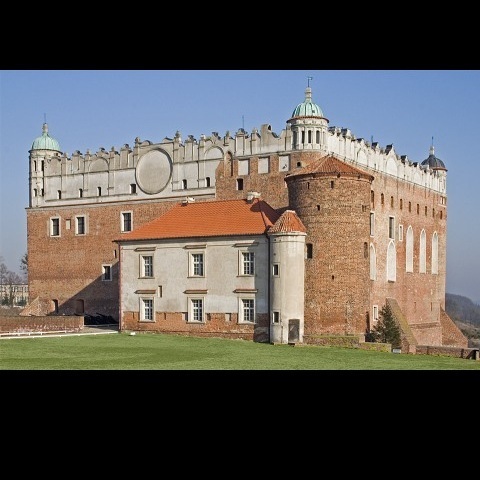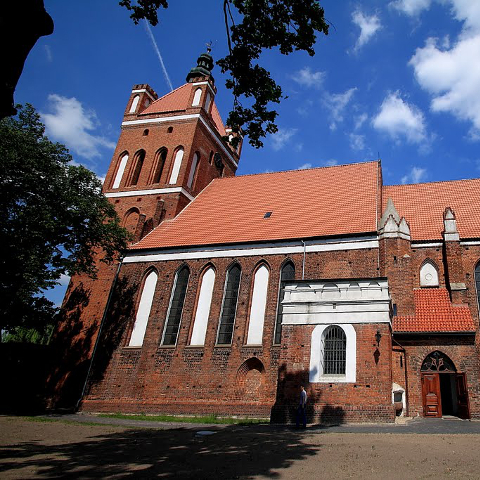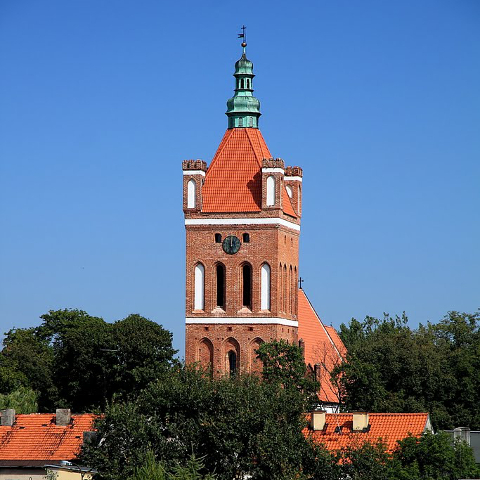Composers / Fryderyk Chopin / Places catalog
Golub
Golub lies on the right bank of the River Drwęca, in the Voivodeship of Kujawy-Pomerania. It used to be a town in its own right, but was amalgamated with Dobrzyń in 1951 to create the town of Golub-Dobrzyń. Golub is mentioned as a rural settlement (the property of the Bishops of Kujawy) as early as 1254. It was ceded to the Teutonic Knights at the end of the thirteenth century, but following the Second Peace of Thorn (Toruń), in 1466, it returned to Poland and was administered by a starosta in the name of the king. Anna Vasa, sister of King Sigismund III Vasa, served as starosta in 1611–1625, during which time the city grew substantially. The king himself visited the city in 1623. Golub fell into gradual decline from the middle of the seventeenth century and was incorporated into Prussia following the Partitions of Poland (1772–1795). In Chopin’s day, the Drwęca was the border between Prussia and Russia. In 1816, Golub had a population of 1,049 and was connected to Dobrzyń via a wooden bridge.
Chopin often visited neighbouring places during the summer holidays he spent at Szafarnia (1824, 1825), and he came across Golub on one of these excursions in 1824. He referred to it drily in the ‘foreign news’ section of his ‘Szafarnia Courier’: ‘On the 26th of the c[urrent] m[onth] and y[ear], His Honour Pichon saw in Golub, among other foreign beauties and specialities, a foreign pig, which occupied the more special attention of this so distinguished voyageur’. Given the proximity of Szafarnia, which is just under 7 km from Golub-Dobrzyń, it can be assumed that there were many more such ‘foreign’ excursions.
An indirect account of Chopin’s stay in Golub has survived. It was reprinted in the periodical Echa Płockie i Łomżyńskie [Echoes from Płock and Łomża District] in 1899 to mark the fiftieth anniversary of the composer’s death. Although it is not fully corroborated by other sources, it is certainly worth quoting. The author employed the pseudonym ‘Józef znad Drwęcy’ [Józef from the Drwęca] and evoked a scene where Chopin displayed his acting talent: ‘A Lutheran church was being built there, and the company had come down to see it. Once everyone was inside the church, where work was in progress, young Fryderyk and Dominik Dziewanowski went up to the pulpit. Fryc began to imitate the pastor in the most comical German-accented broken Polish. Dominik, hiding behind him, slipped his hands into Fryderyk’s sleeves and matched his gestures to his speech in the funniest way. Not only was the entire company amused, but all the workers were doubled up with laughter’.
Although no detailed accounts of Chopin’s stay in Golub have survived, it is a fair bet that he visited the stately and picturesque hilltop citadel of the Teutonic Knights. The castle was built at the behest of Commander Konrad von Sack in 1296–1306. The citadel originally consisted of the castle and the octagonal tower in the north-west corner. The bailey (which has not survived), and the surrounding walls and towers were later additions. Construction was completed in 1330 with the addition of two turrets over the western corners and an annexe beside the entrance gate. The bailey is separated from the castle by a dry moat. The seventeenth-century ‘horse steps’ that lead from the courtyard to the interior of the castle are especially noteworthy. They owe their name to their having been specially designed to enable the knights to ride their horses right up into their chambers.
Under Anna Vasa, the castle was extended and endowed with the hallmarks of a Renaissance palatial residence (including an ornamental attic). During the nineteenth century, the citadel fulfilled a variety of roles. Among other things, it served as a French military hospital (1807) and a Prussian prison (1833), before gradually falling into dilapidation from the middle of the century. It was restored in the 1960s. The castle now houses a branch office of the Polish Tourism and Sightseeing Society (PTTK), which runs a Regional Museum there. The collection numbers over 500 archaeological, ethnographic and historical (especially military) artefacts. Many events are held there, including an International Knights’ Tournament and a Nationwide Public Speaking Competition.
Worth seeing in front of the castle is the powerful cannon, which in a famous scene from the film The Deluge was blown up by Kmicic during the defence of Częstochowa.
Apart from the castle, other sights worth seeing include the Gothic Church of St Catherine, which dates from the fourteenth century and houses a fragment from a late Gothic polychrome dating from the early sixteenth century, an early seventeenth-century townhouse, ‘Pod Kapturem’, a wooden house from the late eighteenth century on the market square and the classicist Church of St Catherine, from 1823, founded by Antoni Wybraniecki, the owner of Sokołów and the stepfather of Jan Białobłocki (a school friend of Chopin).
-

Castle of Teutonic Knights in Golub. Phot. Adam Kumiszcza.
-

Church of St. Catherine from XIV century. Phot. Andrzej Maćkiewicz.
-

Church of St. Catherine from XIV century. Phot. Andrzej Maćkiewicz.
-

Church of St. Catherine of Aleksandria from 1823. Phot. Andrzej Maćkiewicz. [en]